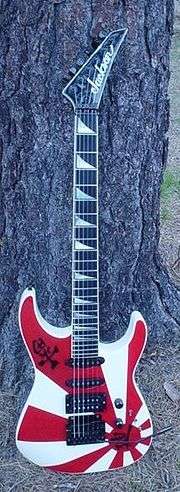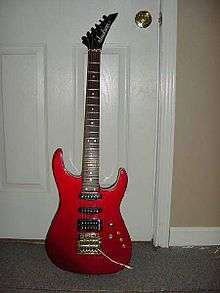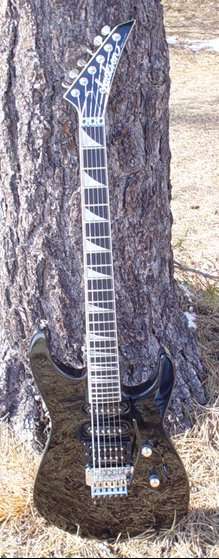Jackson Soloist
| Jackson Soloist | |
|---|---|
 | |
| Manufacturer | Jackson Guitars |
| Period | 1984 - Present |
| Construction | |
| Body type | Solid |
| Neck joint | Neck Thru |
| Woods | |
| Body | Alder, Mahogany |
| Neck | Maple, Mahogany |
| Fretboard | Ebony |
| Hardware | |
| Bridge | Locking tremolo and String thru |
| Pickup(s) | H-H, some artist signatures use H-S-H or H |
| Colors available | |
| Black, Quicksilver, Natural, Cherry Sunburst | |
The Jackson Soloist is an electric guitar model by Jackson Guitars officially produced since 1984 (prototypes were available in the early 1980s). Jackson was essentially the pioneer of the "Superstrat" design. Overall design started as a superstrat with differences from the Stratocaster such as a neck-thru design and often a Floyd Rose double-locking tremolo bridge and premium woods.
As the 1980s brought up a shredding guitarist phenomenon, the Soloist was acclaimed in rock and metal music, especially by lead guitarists.
History
San Dimas era (early-mid 1980s)
There are examples of the Soloist idea going back to the days before Jackson was an official company and just a side project of Grover Jackson while he was running Charvel. Early examples have set necks, Stratocaster-shaped bodies, Explorer style headstocks, and often Charvel appointments like vintage tremolos. In the earliest days of the official Jackson company, the general Soloist style was not quite official. These models often have variations in items that later became standard like size and shape and controls placements.

The first official Soloist was serial #J0158 completed August 28, 1984 (though later serial numbered guitars were completed a week and a half earlier). Before that the Soloist styled guitars were named "Custom Strat" or "Neck-Through Body Strat" guitars. The earlier models were typically true custom guitars that follow no real standard. By the time J0158 came around the factory had a basic spec outline used as a default on all guitars ordered and only changed when specified by the customer.
Original platforms
- The Soloist Custom: standard neck-thru the body, 24 frets, ebony fretboard, "Sharkfin" or dot genuine pearl inlays, binding on the fretboard and headstock.
- The Soloist Student: standard neck-thru the body, 24 frets, rosewood fretboard, genuine pearl dot inlays.
The intended meanings of the model designations was to be similar to Gibson Les Paul Standard (Student in this case) and Les Paul Custom. The designations do not make one a lower quality instrument and the two are made in exactly the same fashion.
Original options
Originally the customer had the choice of 3 different bridges:
- Floyd Rose tremolo;
- Kahler cam tremolo;
- String through the body (Rhoads style)
Pickup options were vast. A customer could get any configuration and any brand. The standard pickup brand was Seymour Duncan until very early 1985 when the company began using in-house wound pickups standard.
Finishes were practically unlimited. While the standard colors were Platinum Pink, Ferrari Red, Ivory and Black, any custom color or airbrushed graphic was available for an upcharge.
Some items changed to help cut costs and speed up production. An example of such a change was in the mid-1980s, when the hand-shaped nibs in the binding beside the frets were discontinued to save time hand-shaving the binding between each fret. In-house manufactured pickups also became standard. Necks were also changed from a laminated style early in the year to a single piece of wood to prevent wood wastage.
Ontario era (late 1980s)
1986 was the year the company moved from Glendora aka San Dimas and over to Ontario. 1987 they began using a Floyd Rose-styled tremolo made in Asia with their name on the top plate. It was still possible to purchase a Floyd Rose or Kahler tremolo bridge, but the JT-6 Jackson unit was the default. A quick way to differentiate the different bridges was to look at the nut at the furthest end of the fretboard. If the nut was the primary nut with screws that go through the neck to the back, it was a Floyd Rose tremolo equipped from the factory. If the clamp was behind the nut and mounted to the surface, it was equipped with a JT6.

Also, the archtop Soloists were introduced. The initial runs were made with Brazilian rosewood fretboards, flamed maple tops and mahogany necks and backs.
Graphic finishes were very popular in this era. The list of common styles is long and unique styles even longer. In-house manufactured pickups became standard in the beginning of 1985, and mid-boost controls were introduced in many guitars.
Pickups were handwound by ex-Fender employee Abigail Ybarra, as discovered by Fender Custom Shop founder John Page who visited Jackson in the early 1990s to purchase their then-unused pickup winding machines and found her working there. She was hired by Jackson in 1985 when the Fender factory closed down and when Fender was sold by CBS to FMIC. The expensive Masterwound pickups were wound by her and possibly the same machine since the mid-late 1980s.
Up to this point these guitars were each made to order and each was given a serial number that matched a detailed work order.
Production era (1990s)

The next big change occurred in 1990. At this time the company decided to offer Soloists in production runs rather than make them to order. These are marked by the UO serial number code. The J+4 digit number continued on only through the Custom Shop.
Many different models were unveiled through the 1990s. It also saw the introduction of the imported Jackson Soloists at this time. The JT6 tremolos were dropped in favor of the Schaller Floyd Rose style, which are recessed into the face of the body. Later in the decade, genuine Floyd Rose models returned.
Basic ID
Domestic headstock logos will have "Made in USA" below or beside the logo. Guitars with the "Professional" and "Performer" logos are always imported. A USA J series serial number will always have 4 or 5 digits later, but any more means that it is an imported guitar. Archtop Soloist models have a JA + 4 digit number serial number.
For the 1980s custom era, the two standard classifications are the Student and Custom model. Student models feature rosewood fretboards and dot inlays. Custom models feature ebony boards, sharkfin inlays, and binding on the headstock and neck. There are many examples which blur the line. Often one can find examples with alternate fretboard material, or Students can have binding. Remember, any option was available for the asking.
Soloist models always are neck-thru the body construction.
Later Models
There are many variations on the Soloist's basic design in production, but they can be split into four basic groups: SL1, SL2, SL3 and SLSMG.
The SL1
The SL1 is the flagship Soloist model. It has an alder body intersected by a quartersawn maple neck-thru neck. The bound fingerboard is made from ebony and has 24 jumbo frets and triangular "shark tooth" inlays made from mother of pearl (all SL1 and SL2H models use real mother of pearl for their inlays). The SL1 uses a Floyd Rose original double-locking tremolo. It also has an HSS pickup array of Seymour Duncans, with the neck and middle pickups being single-slot overlapping Classic Stack humbuckers, while the bridge pickup is a TB-4 [Jazz/Blues] "Trembucker" humbucking pickup. The SL1T is the same guitar, except for the addition of a fixed bridge. All SL1s are made in the US.
The SL2H
The SL2H (the 'SL2' is a different model which was produced in the years 1996-1997) shares the same characteristics with the SL1 except the pickup configuration. The guitar is made up of the same wood, 24 frets, neck-thru construction, same bridge, etc. Contrary to the SL1 the SL2H only has 2 Seymour Duncan pickups at neck and bridge positions. In addition, the SL2H uses a 3 way toggle selector switch rather than the 5-way selector blade found on the SL1 and SL3. The SL2H features an "Original" Floyd Rose locking vibrato, while the SL2HT uses a fixed bridge. The SL2H-MAH is made of mahogany (neck and body "wings"), with a transparent paint finish on both body and headstock. All SL2Hs are made in the US.
The SL2 is again a USA made Soloist with neck-thru construction (all Soloists have neck-thru constructions). The SL2 can be considered a more modest version of the SL2H, made up of maple thru-body neck and poplar wings, with an ebony board and "optional" sharktooth inlays. Most of them had a plain fingerboard without inlaid markers on it. The bridge is Jackson's Floyd Rose-licensed double locking tremolo JT-580 which is widely used on Japanese-made Jacksons. The Jackson logo is not "mother of pearl" on SL2s while it is on SL2Hs.
The SL3
The SL3 belongs to Jackson's Pro Series guitars. The body is made of alder and includes a flamed maple veneer on transparent finish models. The SL3 features the traditional Soloist setup of two single-coil slots for the neck and middle positions and a hot humbucker in the bridge position. Seymour Duncan Hot Rails are fitted in the single-coil slots and a Seymour Duncan JB humbucker occupies the bridge position. Additional features include an FRT-02000 or JT-580 double-locking tremolo, 24 frets, a compound radius Rosewood fretboard, sharktooth inlays and matching headstocks on transparent finish models. Jackson SL3s are manufactured in Japan. There is also a newer MG-version of it, SL3MG, which has the same features but with EMG 81/85 set. Also there was a very high quality Japanese manufactured model that came to the market from the year 2000 till 2002 - the SL4 and it was from the high models of the Jackson guitars as they were made from alder or mahogany for the body-maple or mahogany for the necks but with two differences from the SL1 or the SL3 of Japan that were built late 1990s and early 2000s—the SL4 comes with 22 comfortable frets-humbucker pickups and Takeuchi JT 580 lp bridge units, as the model was coming in solid-trans-quilted maple finishes. Alongside the American lines of Jackson guitars there was other economic line—in prices—from 1987 till nowadays that called Pro lines for all Jackson models, and the top of these models in Soloist model were the 1990s models till 1996.
The SLSMG
The SLSMG (Super Lightweight Soloist MG) is the entry level Soloist model and belongs to Jackon's MG series guitars. It features the neck-thru design that is obligatory for any Soloist. Along with the discontinued U.S. made SLS, the SLSMG is one of the few Soloist models not to feature the traditional pointed Jackson headstock with six inline tuners. Instead the headstock is fitted with a three tuners per side setup. Models released prior to July 2006 featured passive EMG HZ-H3 pickups while models released after this date are equipped with active EMG 81s and 85s in the bridge in the neck positions. The SLSMG's carved body is made from mahogany. The string-thru design makes the SLSMG one of the few Soloists without a Floyd Rose tremolo. All SLSMGs are made in Japan.
The Chicago MG
Jackson briefly partnered with Washburn International with headquarters in Vernon Hills, Illinois and for a short time manufactured a version of the MG model on Elston Avenue in downtown Chicago. Additional models of the MG were imported for Washburn to Jackson's specifications. At that time, Jackson began to experiment with CNC equipment to customize the geometry of individual necks to the requirements of various artists. Other MG components were precision CNC machined by a local stair manufacturer resulting in high precision, repeatable MG assemblies.